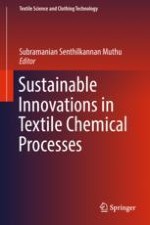2018 | OriginalPaper | Buchkapitel
3. Sustainability in Wastewater Treatment in Textiles Sector
verfasst von : P. Senthil Kumar, A. Saravanan
Erschienen in: Sustainable Innovations in Textile Chemical Processes
Verlag: Springer Singapore
Aktivieren Sie unsere intelligente Suche, um passende Fachinhalte oder Patente zu finden.
Wählen Sie Textabschnitte aus um mit Künstlicher Intelligenz passenden Patente zu finden. powered by
Markieren Sie Textabschnitte, um KI-gestützt weitere passende Inhalte zu finden. powered by
